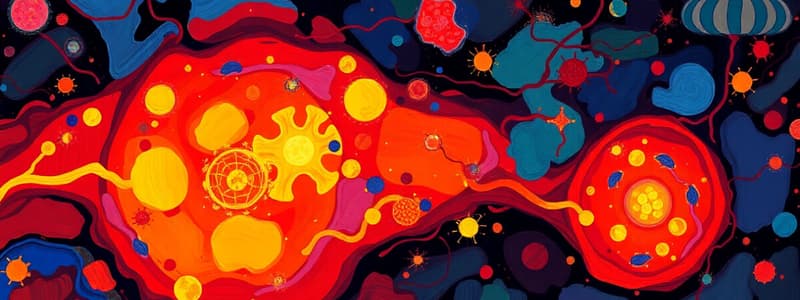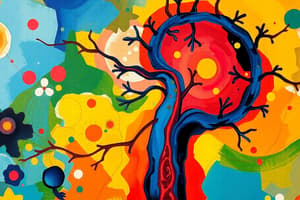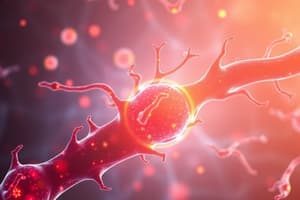Podcast
Questions and Answers
What characterizes the systemic manifestations of acute inflammation?
What characterizes the systemic manifestations of acute inflammation?
- Fever caused by pyrogens (correct)
- Immediate tissue repair and regeneration
- Redness and swelling at the injury site
- Phagocytosis initiated by B cells
Which type of exudate indicates an advanced bacterial infection?
Which type of exudate indicates an advanced bacterial infection?
- Serous exudate
- Hemorrhagic exudate
- Purulent exudate (correct)
- Fibrinous exudate
What is the role of mast cells during inflammation?
What is the role of mast cells during inflammation?
- Facilitate the clotting process
- Consume pathogens through phagocytosis
- Release histamine and other chemicals (correct)
- Secrete antibodies to fight infection
How does chronic inflammation differ from acute inflammation?
How does chronic inflammation differ from acute inflammation?
Which cell type is primarily responsible for initiating phagocytosis?
Which cell type is primarily responsible for initiating phagocytosis?
Flashcards
What are the 4 cardinal signs of inflammation?
What are the 4 cardinal signs of inflammation?
Redness, heat, swelling, and pain.
What is the role of the inflammatory response?
What is the role of the inflammatory response?
It is the body's initial response to injury, aiming to limit damage, prevent infection, and initiate healing.
What happens during the vascular phase of inflammation?
What happens during the vascular phase of inflammation?
Blood vessels dilate, increasing permeability and leakage of fluid into the injured area. White blood cells adhere to the vessel walls and migrate into the tissue.
What is the difference between acute and chronic inflammation?
What is the difference between acute and chronic inflammation?
Signup and view all the flashcards
What are the 3 phases of wound healing?
What are the 3 phases of wound healing?
Signup and view all the flashcards
Study Notes
Innate Immunity: Inflammation and Wound Healing
-
First Line of Defense (Innate Immunity):
- Physical Barriers:
- Skin
- Linings of the GI tract
- Mucus membranes
- Chemical barriers from epithelial cells (saliva, tears)
- Antimicrobial peptides
- Normal microbiome
- Second Line of Defense (Inflammation):
- Nonspecific Inflammatory Response:
- Redness, heat, swelling, pain, loss of function
- Blood vessel dilation
- Increased vascular permeability
- White blood cell adherence and migration
- Vascular Responses:
- Blood vessel dilation and increased permeability
- White blood cells adhere to vessel walls and migrate through them
- Nonspecific Inflammatory Response:
- Physical Barriers:
-
Immune System (Innate & Adaptive):
- Innate:
- Surface Barriers: Physical and chemical barriers
- Internal Defenses: Inflammation, phagocytosis, fever, antimicrobial proteins
- Adaptive (Specific Immunity):
- Humoral Immunity (B-cells): Antibodies produced to attack pathogens
- Cellular Immunity (T-cells): Cytotoxins destroy infected or cancerous cells; need adequate levels for protection
- Lymphocytes: Stored in lymph nodes, produced in greater quantities during illness, filter pathogens, and get swollen when sick.
- Innate:
Adaptive Immunity
-
Lymphatic System:
- Lymph nodes: Locations where white blood cells are stored. Lymph nodes also filter pathogens in the body.
- During illness, more white blood cells are released from lymph nodes leading to swelling.
-
Hypersensitivity Reactions (Type I):
- Overreaction to antigens leads to an allergy or other hypersensitivity reaction
- Release of excessive amounts of IgE antibodies and histamines cause symptoms like hives.
Infection
-
Infection Process:
- When microbes or parasites successfully invade and reproduce, the body can be infected
- Factors influencing infection:
- Encounter, transmission, colonization, invasion/penetration, and dissemination.
- Cellular/tissue damage, communicability, immunogenicity, infectivity, pathogenicity, portal of entry, toxins, mechanism of action
- Stages: Incubation (initial exposure to symptoms), prodromal (initial mild symptoms), invasion/illness (rapid pathogen multiplication, further symptom development), and convalescence (immune/inflammatory system removal of pathogens, decrease in symptoms and resolution)
-
Infection-Related Effects: Bacteria, viruses, fungi, and other biological agents can lead to or be the cause of infection that damages body tissue and leads to other problems
Types of Diseases
-
Bacterial Infections:
- Bacteremia: Presence of bacteria in blood
- Septicemia: Presence of toxins, often from gram-negative bacteria
-
Viral Infections:
- Viruses don't have independent reproduction and replicate by infecting host cells; they need a host cell to survive
- Viral replication is necessary for the virus to spread and infect other cells
-
Fungal Infections:
- Fungi often remain superficial (on the skin)
- Candida is a common infection
Phases of Wound Healing
- Primary Intention:
- Occurs with surgical incisions when skin edges are close together
- Secondary Intention:
- Widespread tissue damage or trauma; healing occurs from inside out due to infection or wound size making suture closing unachievable
- Wound Healing Process (general):
- Inflammation, proliferation, remodeling and maturation
Factors Hindering Wound Healing
- Other medical problems (diabetic, circulatory, other medical problems), smoking, and general lack of health can cause problems with wound healing.
Studying That Suits You
Use AI to generate personalized quizzes and flashcards to suit your learning preferences.
Related Documents
Description
Explore the intricacies of innate immunity, focusing on the body's first line of defense through physical and chemical barriers. This quiz also delves into the second line of defense, inflammation, highlighting the physiological responses involved in wound healing. Test your understanding of how these processes work together to protect the body.




